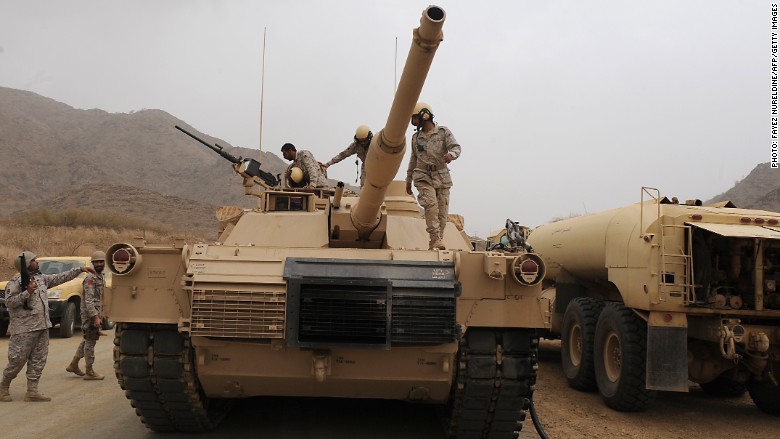Global arms trade hits highest level since end of Cold War
by Ivana Kottasova @ivanakottasovaFebruary 20, 2017: 4:53 AM ET
And the world's biggest arms dealer is ...
Related: China's weapons sales to other countries are soaring
"The U.S. has delivered a lot of weapons in 2016, both very expensive weapons and strategically important weapons -- missile systems, surveillance and navigation technology," said Aude Fleurant, the director of SIPRI's arms and military expenditure program.
"The weight of the U.S. in the global arms trade is so big that it's enough to shape the trend," Fleurant said. It has delivered major weapons to at least 100 countries over the five-year period, significantly more than any other exporting country.
Of all the weapons the U.S. exported in the last five years, 47% ended up in the Middle East. The main buyers were Saudi Arabia, the UAE and Turkey.

Arms imports to Saudi Arabia have increased dramatically in recent years.
Many countries in the Middle East are involved in the armed conflicts in Syria and Yemen. Others like Iraq are battling insurgents on their own territory. The violence in Syria erupted nearly six years ago, while the Saudi-led intervention in Yemen began almost two years ago.
At the same time, relations remain tense between Iran and many of its neighbors.
Related: China's defense spending to double to $233 billion
Arms imports by countries in the Middle East increased by 86% in the five years through 2016, compared with the previous five years. Among the biggest jumps were Saudi Arabia's (up 212%) and Qatar's (up 245%).
Rising oil wealth had made it possible for Middle Eastern countries to ramp up their military spending -- but that's not expected to last.
"Because weapons contracts take a very long time to complete, we are now seeing deliveries that were agreed years ago, when the oil price was high," Fleurant said.
She said the recent crash in oil prices will inevitably lead to a decline in arms trade in the region.
Related: Boeing wants to cash in on India's military spending spree
Imports by countries in Southeast Asia have also increased over the past five years, fueled by contentious territorial disputes in the South China Sea.
The area is home to crucial shipping lanes, and it's rich in oil and gas reserves. China, Taiwan, Vietnam, the Philippines, Malaysia and Brunei have all made territorial claims over islands in the area.
Tensions have grown since 2014 as China has turned sandbars into islands, equipping them with airfields, ports and weapons systems and warned U.S. warships and aircraft to stay away from them.
Related: What's at stake in South China Sea
SIPRI said most of the weapons acquired by the countries in the area, including frigates, submarines, support ships, combat aircraft and anti-ship weapons, have a maritime role.
http://ht3.cdn.turner.com/money/big...al-arms-trade-explainer.cnnmoney_1024x576.mp4
by Ivana Kottasova @ivanakottasovaFebruary 20, 2017: 4:53 AM ET
And the world's biggest arms dealer is ...
Related: China's weapons sales to other countries are soaring
"The U.S. has delivered a lot of weapons in 2016, both very expensive weapons and strategically important weapons -- missile systems, surveillance and navigation technology," said Aude Fleurant, the director of SIPRI's arms and military expenditure program.
"The weight of the U.S. in the global arms trade is so big that it's enough to shape the trend," Fleurant said. It has delivered major weapons to at least 100 countries over the five-year period, significantly more than any other exporting country.
Of all the weapons the U.S. exported in the last five years, 47% ended up in the Middle East. The main buyers were Saudi Arabia, the UAE and Turkey.

Arms imports to Saudi Arabia have increased dramatically in recent years.
Many countries in the Middle East are involved in the armed conflicts in Syria and Yemen. Others like Iraq are battling insurgents on their own territory. The violence in Syria erupted nearly six years ago, while the Saudi-led intervention in Yemen began almost two years ago.
At the same time, relations remain tense between Iran and many of its neighbors.
Related: China's defense spending to double to $233 billion
Arms imports by countries in the Middle East increased by 86% in the five years through 2016, compared with the previous five years. Among the biggest jumps were Saudi Arabia's (up 212%) and Qatar's (up 245%).
Rising oil wealth had made it possible for Middle Eastern countries to ramp up their military spending -- but that's not expected to last.
"Because weapons contracts take a very long time to complete, we are now seeing deliveries that were agreed years ago, when the oil price was high," Fleurant said.
She said the recent crash in oil prices will inevitably lead to a decline in arms trade in the region.
Related: Boeing wants to cash in on India's military spending spree
Imports by countries in Southeast Asia have also increased over the past five years, fueled by contentious territorial disputes in the South China Sea.
The area is home to crucial shipping lanes, and it's rich in oil and gas reserves. China, Taiwan, Vietnam, the Philippines, Malaysia and Brunei have all made territorial claims over islands in the area.
Tensions have grown since 2014 as China has turned sandbars into islands, equipping them with airfields, ports and weapons systems and warned U.S. warships and aircraft to stay away from them.
Related: What's at stake in South China Sea
SIPRI said most of the weapons acquired by the countries in the area, including frigates, submarines, support ships, combat aircraft and anti-ship weapons, have a maritime role.
http://ht3.cdn.turner.com/money/big...al-arms-trade-explainer.cnnmoney_1024x576.mp4
